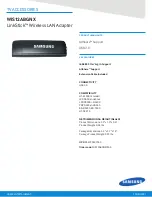
WiSnap User Manual 4.41 05282015-ML
Page 33
Trigger=0x1
Autoconn=0
IoFunc=0x0
IoMask=0x21f0
PrintLvl=0x1
The table below shows the usage of the GPIO pins with their default state and functionality:
Bit
Signal Name
RN-131
Default State
RN-171
Default State
Default Function
0
GPIO0
N/A
N/A
-
1
GPIO1
N/A
Input
Unused
2
GPIO2
N/A
Input
Unused
3
GPIO3
N/A
Input
Unused
4
GPIO4
Output
Output
Green LED
5
GPIO5
Output
Output
Yellow LED
6
GPIO6
Output
Output
Red LED
7
GPIO7
Output
Output
Blue LED
8
GPIO8
Input
Output
Unused
9
GPIO9
Input
Input
Ad hoc mode and factory reset
10
GPIO10
Output
Output
UART TX
11
GPIO11
Input
Input
UART RX
12
GPIO12
Input
Input
Throttles the transmitter if hardware flow control is enabled.
Driving this pin low enables transmitter; driving this pin high
disables it.
13
GPIO13
Output
Output
This pin goes high on power up and goes low when the system
is ready. If hardware flow control is enabled, this pin toggles
high to indicate the RX buffer is full
14
GPIO14
N/A
Input
-
NOTE:
The Blue LED is connected to GPIO7 on the WiSnap AAA. The Blue LED is not connected to GPIO7 on the
WiSnap SuRFBoard (M1). It is not possible to power off the Blue LED on the SuRFBoard because it is connected directly
to power.
10.5.1
Setting the alternate GPIO functions
The defaults for GPIO 4, 5, 6 are to control the LED functionality. This default functionality can be overridden to allow user
programmable IO or alternate IO functionality by using the
set sys iofunc
<value>
command. Value is entered as a hex
number.
The hex value represents a bit mask that controls each bit in the <value> represents a particular GPIO pin. If a bit is 0, then
that GPIO is driven/read by the firmware per the default function.
The IO function <value> is encoded as such:
Bit
Signal Name
Direction
Function
0
GPIO4
Output
Disable the LED function so the I/O can be used as a GPIO pin.
1
GPIO5
Output
Disable the LED function so the I/O can be used as a GPIO pin.
2
GPIO6
Output
Disable the LED function so the I/O can be used as a GPIO pin.
3
Unused
-
-
4
GPIO4
Output
This pin goes high after the module has associated/authenticated and has an IP
address.
5
GPIO5
Output
Set this pin high to trigger a TCP connection and low to disconnect.
6
GPIO6
Output
This pin goes high when the module is connected over TCP and low when
disconnected.
















































